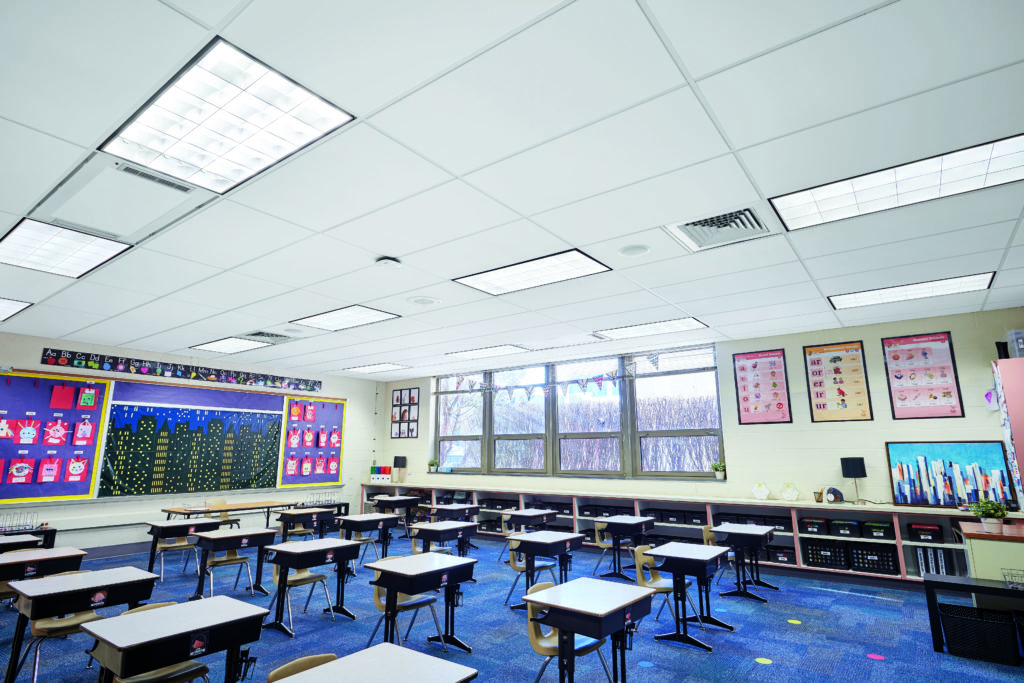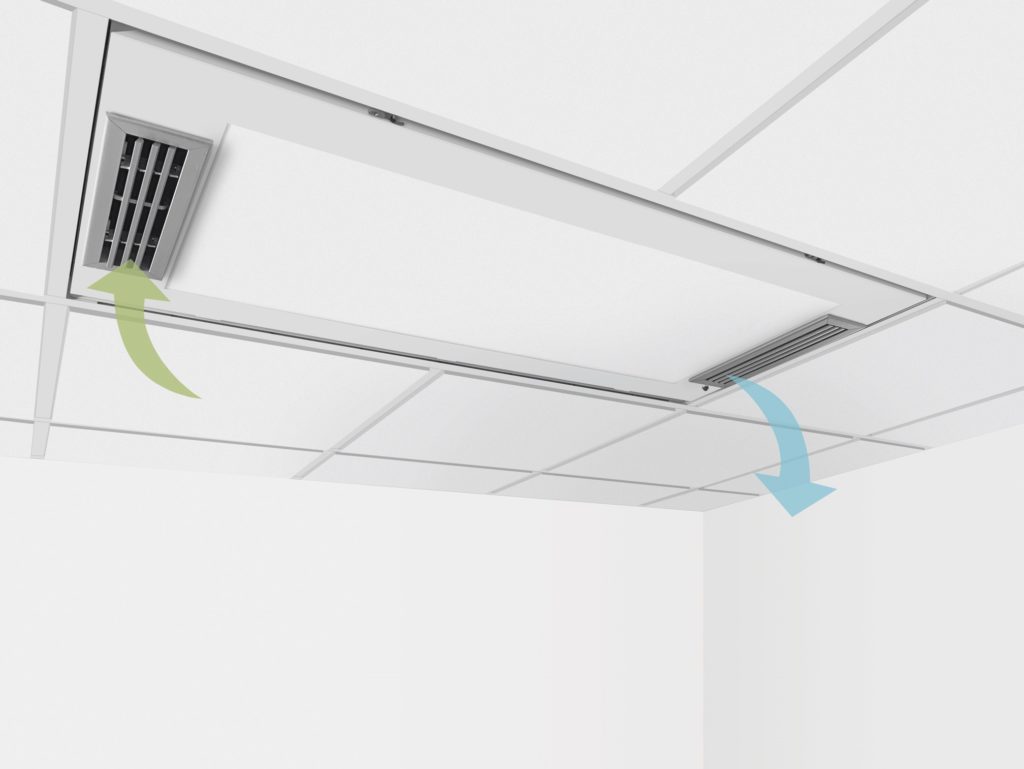Since the outbreak of COVID-19, America’s schools have closed and opened and provided online, hybrid, and in-person schooling to keep students safe and school in session. Whatever your role − you are aware of efforts around social distancing, mask wearing, deep cleaning and plexiglass panels. However, less known are longer-term mitigation efforts like improving indoor air quality. Paying attention to our schools’ air quality will not only keep people healthier now but may also increase learning and student success long term.
According to a study by Lawrence Berkley National Laboratory, improving ventilation rates have been linked to fewer missed school days. Another study of 100 U.S. elementary classrooms by the Tulsa School of Air Quality1, observed positive associations between improved indoor air quality and performance on standardized tests in math and reading. In his book, Healthy Buildings, author Joseph G. Allen, director of the Healthy Buildings program and associate professor at Harvard’s T.H. Chan School of Public Health, concludes that up to 90% of schools in the U.S. are not meeting the minimum ventilation standards set by the American Society of Heating, Refrigeration and Air Conditioning Engineers (ASHRAE).
A crucial part of rebooting our schools for the fall is providing a safe and healthy space to the best of our ability now. To that end, all precautions should be taken to comply with guidelines to provide a safe, healthy environment and minimize exposure to COVID-19 and other airborne pathogens.

ASHRAE Recommendations on HVAC
In providing updated reopening guidelines for schools and universities in July 2020, ASHRAE recommended daily cleaning and air flushing between occupied periods for a duration sufficient to reduce the concentration of airborne infectious particles by 95%. For a well-mixed space, this would require three exchanges of space volume using outdoor air (or equivalent outdoor air, including the effect of filtration and air cleaners). In lieu of calculating the air exchange rate, pre- or post-occupancy flushing periods of two hours may be used since this should be sufficient for most systems meeting minimum ventilation standards.
In its “Position Document on Infectious Aerosols,” ASHRAE states that while ventilation systems cannot address all aspects of infectious control, “changes to building operations, including those of heating, ventilating and air conditioning systems, can reduce airborne exposures.”
ASHRAE further clarifies that “directional airflow can create clean-to-dirty flow patterns and move infectious aerosols to be captured and exhausted.” The document lists several recommendations for consideration to reduce occupant exposure to infectious aerosols. Among them are strategies to improve ventilation through dilution, airflow patterns, filtration and pressurization. A few of the challenges in implementing the ASHRAE recommendations include higher energy costs and decreased airflow as higher-rated Minimum Efficiency Reporting Value (MERV) filters are implemented.
Three Simple Solutions
One solution includes HVAC system upgrades. Increasing the effectiveness of HVAC systems could be one of the keys to controlling the transmission of COVID-19. A less expensive, easier-to-install and potentially more effective solution is utilizing suspended ceiling technologies combined with improved filtration. Below are three simple solutions available today.

Cleanability
Cleaning and disinfecting desks, door handles, countertops and other surfaces is essential to providing a safe, healthy space. But what about ceilings that can comprise 20% or more of total indoor surfaces? While heavy contaminants may fall, aerosols can rise and cling to ceilings. Today, many smooth-textured ceiling panels can be cleaned based on CDC recommendations by either wiping, spraying or fogging to eliminate pathogens. Many are also bacteria and mold/mildew resistant.
Structural
One of the added challenges currently facing a return to school is addressing the recent trend of collaborative spaces and larger, open-air commons type settings with higher structural ceilings that expose duct and pipework. The installation of a suspended ceiling allows for the easy configuration of permanent or modular individual spaces helping students and staff maintain social distance and lowering the potential spread of pathogens.
A metric used to measure the amount of air entering and exiting a room is air changes per hour (ACH). It is calculated based on the height of the structural ceiling in an open-air model. The incorporation of a suspended ceiling has the effect of reducing the ceiling height, and thus the volume of air needing to be exhausted. Installation of a suspended ceiling reduces room volume, effectively increasing ACH, and lowers the time it takes to clear a space of airborne contaminates.
Leakage Control
Specially engineered suspended ceilings are a proven technology in patient rooms, clean rooms and laboratories to help prevent the spread of contaminants. Today, suspended ceiling panels are available that incorporate a gasket in their design. These systems provide even more control over the volume of air in a room and have been proven to increase the effectiveness of in-ceiling air filtration by up to 40%.
Additionally, there are ceiling systems that combine a UV-C air purification system with the ceiling panels. The design uses ultraviolet light to deactivate pathogens. Third-party testing shows the system neutralizes 97% of infectious pathogens in aerosols during the first pass of air through the system. Each unit provides continuous air cleaning safely and directly from the ceiling plane through a patented, shielded UV-C chamber, increasing the number of air changes in the space.
Case Study
Administrators at Neff Elementary School in Lancaster, Pennsylvania, were interested in a practical solution that could help safeguard students and staff from potential airborne pathogens. When they learned of the innovative ceiling retrofit option created by Armstrong Ceilings, they readily volunteered to test the system in one of their schools. AirAssure ceilings and VidaShield UV24 panels were installed in a 925-square-foot classroom housing 19 students five-to-six hours per day.
The retrofit improved ventilation with a 30% increase in air exchanges. Increased air exchanges are recommended by both the CDC and ASHRAE as a COVID-19 mitigation strategy. Following the retrofit, independent testing also confirmed bacteria and fungi levels within the classroom were greatly reduced due to the UV-C filters. Independent studies performed in the occupied classroom found reductions of 68% of bacteria and 100% of fungi after installation of the VidaShield UV24 system.
This can help contribute to healthier spaces by minimizing allergy and asthma triggers and by reducing the level of other infectious pathogens in the air and the settling of those pathogens onto room surfaces. Commenting on the retrofit, first-grade teacher Tyler Jones says he appreciates the steps taken to keep the classroom safer and healthier. “It provides peace of mind to know that steps have been taken to keep the air clean.”
Cost-Effective Solutions
One worrisome factor that could be preventing the full return to enclosed spaces is the potential cost of implementing the recommended measures that reduce COVID-19 transmission. Today’s ceiling systems provide effective, price-conscious solutions and are easily retrofitted into existing grids. Gasketed panels also enhance the transition to negative- or positive-controlled environments.
Summary
As the nation reopens, ensuring a safe and healthy indoor environment is critical. The confidence of knowing systems and facilities have been implemented or upgraded to potentially reduce the transmission of COVID-19 and other pathogens is paramount before the return of students, staff and others to public spaces.
Suspended ceiling technologies can play an essential role as stand-alone solutions or in conjunction with other products to reduce the spread of infectious aerosols and their cost effectiveness can offset the cost of other system upgrades. School administrators and facility managers should examine their facilities to determine whether suspended ceiling technologies could help prevent the spread of COVID-19 and other airborne pathogens.
(Much of the information in this article is drawn from a white paper prepared by the Thompson Research Group. The white paper discusses how air quality and suspended ceiling technologies can play an important role as stand-alone solutions or work in conjunction with other products to reduce the spread of infectious aerosols. To view this and other white papers and case studies to learn how to create healthier spaces, visit armstrongceilings.com/healthyspaces.)
Notes
- University of Tulsa, Indoor Air Program, Association between substandard classroom ventilation rates and students’ academic achievement, U Haverinen-Shaughnessy , D J Moschandreas, R J Shaughnessy.
- Centers for Disease Control and Prevention, “How COVID-19 Spreads,” October 28, 2020, cdc.gov.
- World Health Organization, “Transmission of SARS-CoV-2. Implications for infection prevention precautions,” July 8, 2020, who.int.
- World Health Organization, “Coronavirus disease (COVID-19). How is it transmitted?” who.int.

